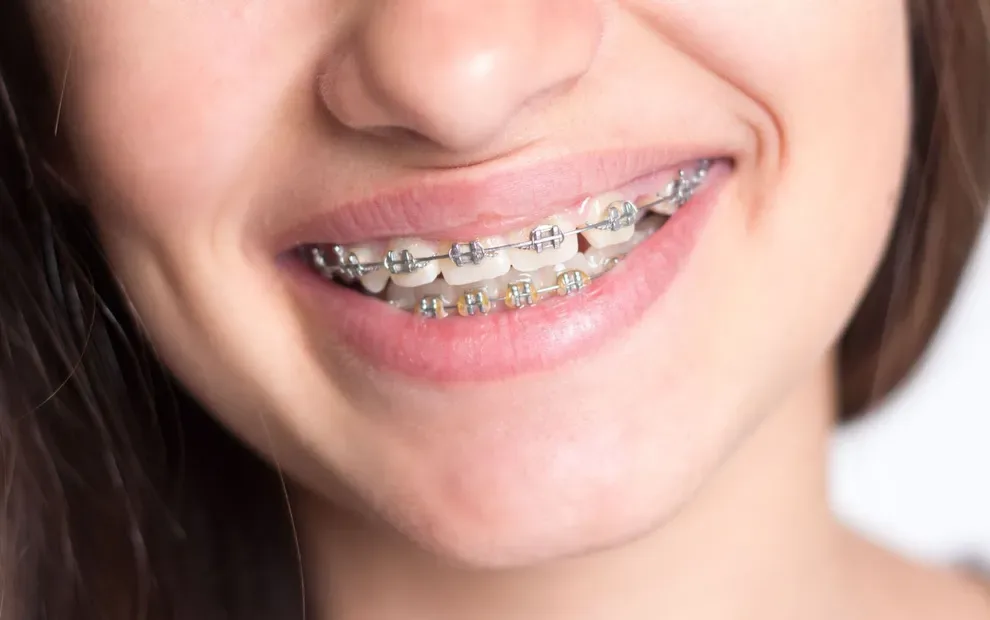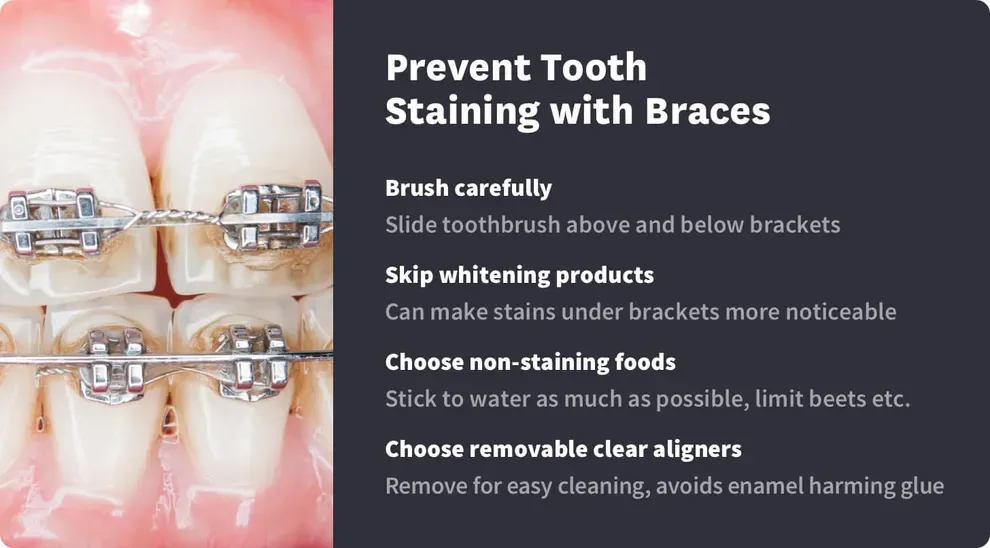How Braces Stain Teeth & Non-Staining Alternatives

Table of Contents
- Braces Stain Teeth
- Appearance of Stains
- Preventing the Problem
- Alternative Options
- References
You've sat in the orthodontist's chair for an hour or two, and the moment has arrived. Your braces are off, and you're holding a mirror up to your smile. You're prepared to be happy, but unfortunately, you notice stains instead.
It's common for people to notice stains on their teeth when braces are removed. Brushing your teeth properly is tough when your surfaces are covered with metal.
But you can choose a different straightening option, like aligners, and avoid the issue altogether.
How Braces Stain Teeth
The brackets and bands that make up braces leave no color behind. Tooth discoloration associated with braces isn't due to the hardware itself. Instead, the glues that hold devices on your teeth, combined with an inability to clean properly, can leave you vulnerable to staining.
While you're wearing your braces, you are expected to:
Brush. You must swirl a toothbrush and paste over your teeth after every meal or snack. But the bristles can get stuck in your brackets, and you may find that you're only touching the hardware and not your teeth.
Pick. It’s difficult to floss between your teeth, as your wires will interfere. But a device like a water jet could help to dislodge particles.
Get cleanings. Regular cleanings are critical, but your dentist can't remove your hardware either.
More than 35 percent of orthodontists remove braces because their customers have poor oral hygiene habits. It's very difficult to keep teeth clean with so much metal in the way. Many people simply give up.
Researchers say that glues used to hold brackets on your teeth can also harm your enamel. Pulling the devices off and polishing your teeth can harm them even more. The surface may grow bumpy and rough, and when that happens, your teeth may stain easily.
What Stains from Braces Look Like
Every tooth has some color variations. Tilt your head just so, and you may see colors you didn't notice before. But stains associated with braces are bright and hard to ignore.
Stains caused by braces may look:
Teeth exposed to relentless bacteria begin to decay. The enamel softens, and the vulnerable area begins to change color.
All of the areas covered by your braces and brackets may look bright white. It's not because the rest of your teeth are unclean. It's because the areas of the teeth you couldn't clean properly due to braces are decaying.
Plenty of foods and drinks can stain your teeth. Coffee, tea, wine, fruit, and vegetables can all leave stains behind. After your braces come off, all the damaged areas may pick up stains quickly and move from white to amber.
If your tooth decay is advanced, you may develop a hole in the enamel. That spot may look brown or black, and it might be painful too.
You may notice the discoloration first. But it's important to remember that these changes are associated with tooth damage. Your teeth need quick care, or the decay may worsen.
When your orthodontist removes your braces, you may have white stains on some or all of your teeth, however the problem happens to almost everyone who wears braces, and it's tough to prevent.

How to Prevent Braces from Staining Your Teeth
You want straighter teeth, but you don't want stains. Can you get one without the other? It's possible, but you'll have plenty of work to do.
Avoiding tooth-color changes due to braces means:
Brushing carefully. Slide the toothbrush both above and below your brackets. Make sure you're touching every surface of your teeth, even if that means doubling the time you spend on dental hygiene.
Skipping whitening products. Use a toothpaste that bleaches teeth, and you may change the color of enamel outside (but not under) your brackets. That can make your stains really pop. Whitening agents can wear down glue and make your brackets come off too.
Avoiding stains. Sip water rather than coffee, tea, or wine. Choose non-staining foods, like strawberries, while leaving the bright versions, like beets, behind.
You can take all of these steps and still have stained teeth from braces. Preventing the issue altogether is almost impossible.
Alternatives to Braces
You're not doomed to live with crooked teeth if you want to avoid stains. Aligners offer the opportunity to straighten your smile without putting the health of your teeth at risk.
Clear teeth aligners are plastic trays made to fit perfectly over your teeth. Every week or so, you swap out an old device for a new version, and that new tray has a subtle design shift. Your teeth move in response, and soon, you have the smile you've been looking for.
No enamel-harming glues are required, as aligners slide over your teeth. And you can remove them for cleaning, so issues involving plaque buildup and bacteria are nonexistent. About 1 percent of people who use aligners have white stains after treatment compared to the more than 25 percent of people with braces who have stains.
Aligners are safe and easy to use. They're often much less expensive than braces too. At Byte, we even offer a tooth whitening product with our aligners, so you can brighten your smile while straightening your teeth.
